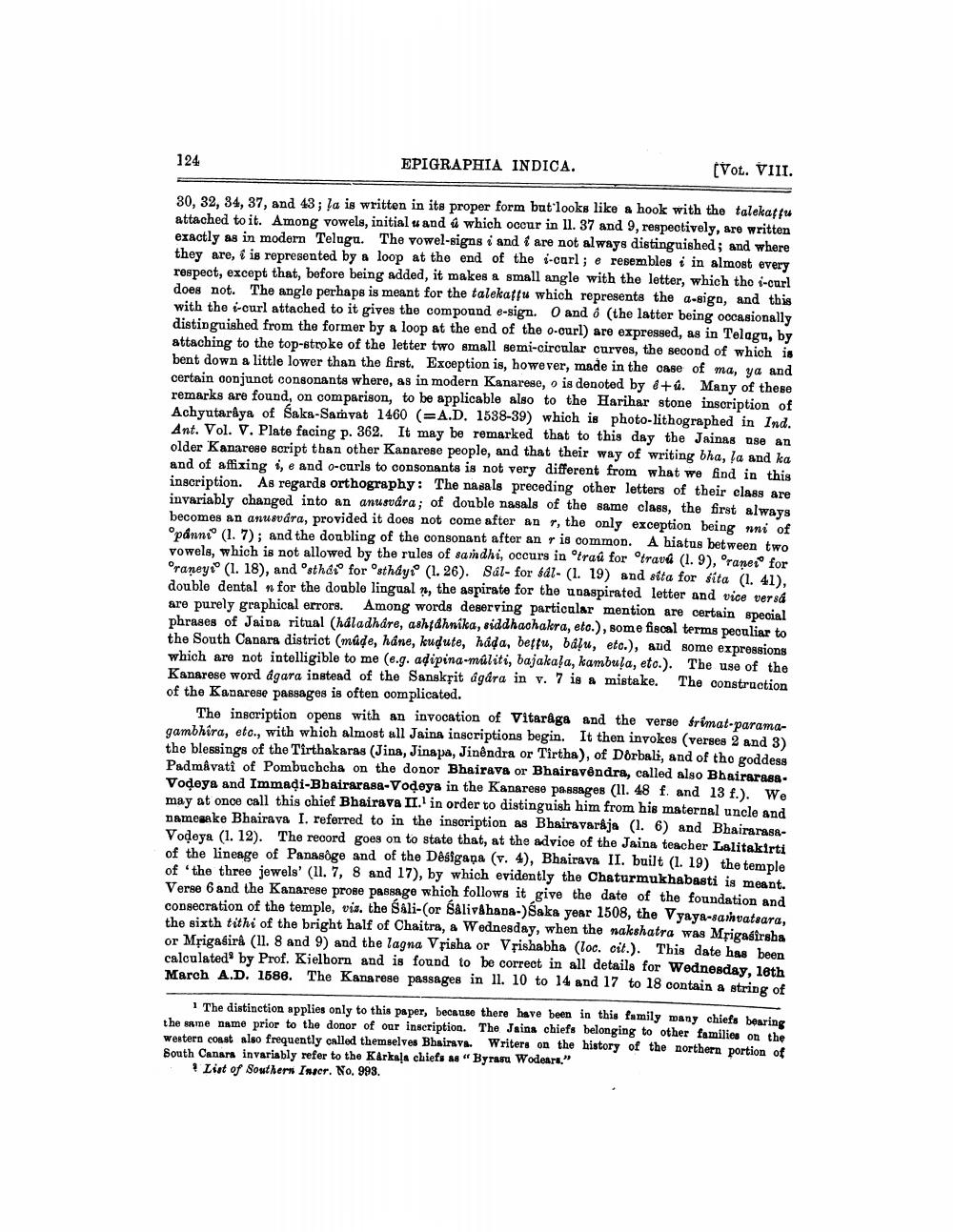________________
124
EPIGRAPHIA INDICA.
[Vol. VIII.
30, 32, 34, 37, and 43; la is written in its proper form but looks like a hook with the talekaṭṭu attached to it. Among vowels, initial u and a which occur in 11. 37 and 9, respectively, are written exactly as in modern Telugu. The vowel-signs i and are not always distinguished; and where they are, is represented by a loop at the end of the i-curl; e resembles in almost every respect, except that, before being added, it makes a small angle with the letter, which the i-curl does not. The angle perhaps is meant for the talekattu which represents the a-sign, and this with the i-curl attached to it gives the compound e-sign. O and ô (the latter being occasionally distinguished from the former by a loop at the end of the o-curl) are expressed, as in Telagu, by attaching to the top-stroke of the letter two small semi-circular curves, the second of which is bent down a little lower than the first. Exception is, however, made in the case of ma, ya and certain conjunct consonants where, as in modern Kanarese, o is denoted by +û. Many of these remarks are found, on comparison, to be applicable also to the Harihar stone inscription of Achyutaraya of Saka-Samvat 1460 (=A.D. 1538-39) which is photo-lithographed in Ind. Ant. Vol. V. Plate facing p. 362. It may be remarked that to this day the Jainas use an older Kanarese script than other Kanarese people, and that their way of writing bha, la and ka and of affixing i, e and o-curls to consonants is not very different from what we find in this inscription. As regards orthography: The nasals preceding other letters of their class are invariably changed into an anusvára; of double nasals of the same class, the first always becomes an anusvára, provided it does not come after an r, the only exception being nni of pánni (1. 7); and the doubling of the consonant after an r is common. A hiatus between two vowels, which is not allowed by the rules of samdhi, occurs in traû for trava (1. 9), °ranes for raney (1. 18), and sthat for sthay (1.26). Sal- for sal- (1. 19) and sita for sita (1. 41), double dental n for the double lingual n, the aspirate for the unaspirated letter and vice versá are purely graphical errors. Among words deserving particular mention are certain special phrases of Jaina ritual (háladháre, ashidhnika, siddhachakra, etc.), some fiscal terms peculiar to the South Canara district (mûde, hane, kuḍute, háda, beṭṭu, bâlu, etc.), and some expressions which are not intelligible to me (e.g. adipina-müliti, bajakala, kambula, etc.). The use of the Kanarese word ágara instead of the Sanskrit ágára in v. 7 is a mistake. The construction of the Kanarese passages is often complicated.
The inscription opens with an invocation of Vitaraga and the verse frimat-paramagambhira, etc., with which almost all Jaina inscriptions begin. It then invokes (verses 2 and 3) the blessings of the Tirthakaras (Jina, Jinapa, Jinêndra or Tirtha), of Dorbali, and of the goddess Padmavati of Pombuchcha on the donor Bhairava or Bhairavendra, called also BhairarasaVodeya and Immadi-Bhairarasa-Vodeya in the Kanarese passages (11. 48 f. and 13 f.). We may at once call this chief Bhairava II.1 in order to distinguish him from his maternal uncle and namesake Bhairava I. referred to in the inscription as Bhairavaraja (1. 6) and BhairarasaVodeya (1. 12). The record goes on to state that, at the advice of the Jaina teacher Lalitakirti of the lineage of Panasôge and of the Desigana (v. 4), Bhairava II. built (1. 19) the temple of the three jewels' (11. 7, 8 and 17), by which evidently the Chaturmukhabasti is meant. Verse 6 and the Kanarese prose passage which follows it give the date of the foundation and consecration of the temple, viz. the Sali-(or Salivahana-) Saka year 1508, the Vyaya-samvatsara, the sixth tithi of the bright half of Chaitra, a Wednesday, when the nakshatra was Mrigasirsha or Mrigasira (11. 8 and 9) and the lagna Vrisha or Vrishabha (loc. cit.). This date has been calculated by Prof. Kielhorn and is found to be correct in all details for Wednesday, 16th March A.D. 1588. The Kanarese passages in 11. 10 to 14 and 17 to 18 contain a string of
1 The distinction applies only to this paper, because there have been in this family many chiefs bearing the same name prior to the donor of our inscription. The Jaina chiefs belonging to other families on the western coast also frequently called themselves Bhairava. Writers on the history of the northern portion of South Canara invariably refer to the Karkala chiefs as "Byrasu Wodears."
List of Southern Inser. No. 993.




